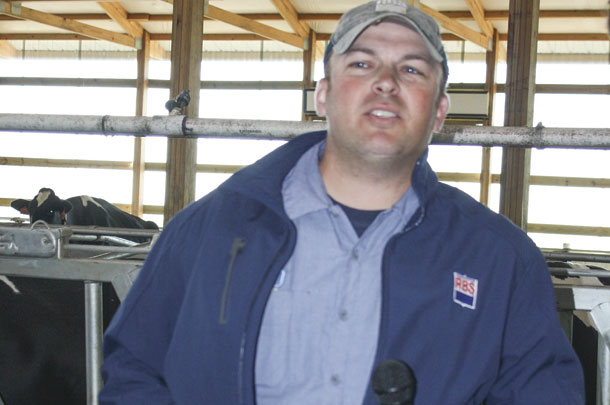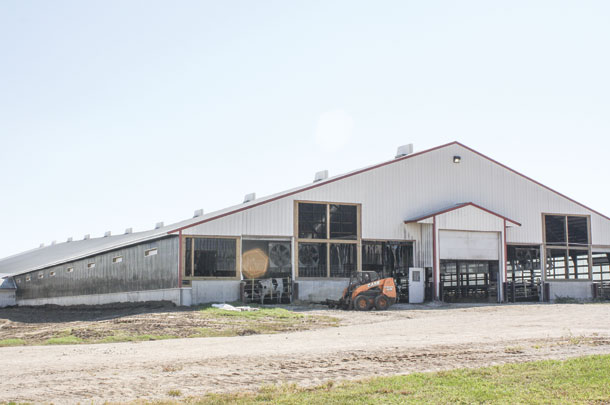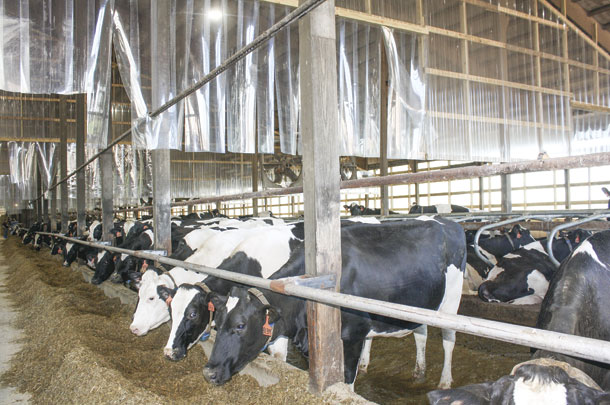From hot and muggy summer nights to frosty winter mornings, Minnesota is known for weather extremes. But at Johnson’s Rolling Acres near Rushford, the cows can’t tell the difference.
Earlier this year, the Johnsons turned a naturally ventilated freestall barn into a tunnel-ventilated facility, allowing them to maintain a more consistent environment year-round. The barn, which was constructed for 750 cows in 2000, was structurally sound, yet it failed to provide adequate cooling and air flow for cows due to obstruction from an adjacent building.
 “Natural ventilation never worked well in this barn,” said Trinity Johnson, who manages the dairy side of the operation. “We had 32 fans running in the barn, but it didn’t help.”
“Natural ventilation never worked well in this barn,” said Trinity Johnson, who manages the dairy side of the operation. “We had 32 fans running in the barn, but it didn’t help.”
After expanding to 1,250 cows and putting up a cross-vent barn in 2012, it became even more apparent mechanical ventilation could offer benefits with cooling and climate control far beyond what the original freestall could provide.

The Johnsons were pleased with the noticeable effect of a cooling wall running the length of one side of this barn combined with fans along the opposite wall to pull the chilled air across the width of the building. According to Trinity, temperatures in the cross-vent barn are typically 10ºF to 12ºF cooler than outside.
The concept of a controlled environment appealed to the Johnsons as they made plans to upgrade the nearly 20-year-old six-row barn. They decided to capitalize on the existing structure by incorporating what they had learned about mechanical ventilation in the enclosed cross-vent facility.
“We closed it up and tunnel-vented it to create a controlled environment,” Trinity said.
The transformation required multiple steps, including replacing curtain sidewalls with smoke paneling and adding 96 feet onto the end of the barn. This not only created an end wall for 24 exhaust fans, but it also made room to house and cool far-off dry cows.
Johnson noted they went with direct-drive fans, and they hope to enjoy reduced maintenance time and costs from not having to replace belts and bearings. The fans are set to incrementally ramp up or down in speed based off temperature, which should also help with controlling energy costs.
To prevent warm, stale air during colder weather, additional fans are located along the ridge of the roof, and small inlets with curtains are strategically placed along the walls, just under the eaves.
Inside the barn, baffles are located every 48 feet to increase air speed as fans pull air the length of the barn. This creates an average wind speed of 7.5 mph (4 mph over top of the cows and 10.5 mph in the feed alley). Flexible belting hangs from the clear polycarbonate panels to allow clearance under the baffles for the TMR truck and sand shooter.

The 32 circulating fans once used to assist natural ventilation still hang over the stalls in the barn but, even through the dog days of the first summer since closing it up, Johnson has yet to turn them on. A sprinkler system supplements cooling efforts.
Johnson looks forward to multiple benefits from the changes made to the barn, particularly related to cooling dry cows and further improving reproduction. “In this barn, we are hoping to improve preg rates over the previous drops we’d experience in the summer,” he said.
Though a fan of the cross-vent barn, Johnson has found a happy medium with the savings in building and operational costs of the now-tunnel-ventilated barn, noting it achieved the same purpose. He concluded, “We are able to control Mother Nature.” ![]()
PHOTO 1: Twenty-four fans provide an average 7.5 mph wind speed in the barn.
PHOTO 2: Trinity Johnson is one of three junior partners who make up the third generation on Johnson’s Rolling Acres. Brothers Mark, Brad and Richard Johnson comprise the senior partnership, carrying on a tradition started by their father, Leroy Sr., a half-century ago with 36 cows.
PHOTO 3: The Johnsons enclosed the naturally ventilated freestall barn built in 2000 by adding paneling along the length of both sides of the building.
PHOTO 4: Flexible belting hangs from the clear polycarbonate panels to allow clearance under the baffles for the TMR truck and sand shooter. Photos by Peggy Coffeen.
Johnson’s Rolling Acres was a featured dairy on the ABS Global Experience tours held Sept. 11-14.

-
Peggy Coffeen
- Editor
- Progressive Dairyman
- Email Peggy Coffeen








